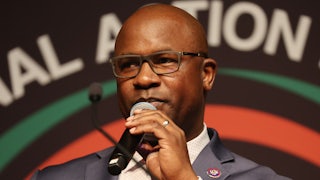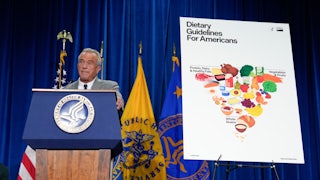Last week, a certain segment of academic economists lost their mind as the White House announced it would knock $10,000 off individual student loan debts, or $20,000 if borrowers are Pell Grant recipients. But another type of recently passed debt relief has attracted comparatively less attention and ire. Rural electric co-operatives—a living legacy of the New Deal’s efforts to bring power to the 90 percent of rural communities that still lacked it in the 1930s—will soon be able to take advantage of a new $9.7 billion program included in the Inflation Reduction Act that will help them finance a clean energy transition, escaping onerous debts that have kept many co-ops from getting off coal. Their newfound access to renewable energy tax credits—also furnished by the IRA—could be a game-changer, bringing more renewables to the 42 million who get their electricity from power providers they own.
Altogether, co-ops are estimated to be on the hook for about $100 billion in outstanding debt. Roughly $45 billion of that is held by the Agriculture Department’s Rural Utilities Service, according to an analysis of Freedom of Information Act documents obtained by campaigners. The RUS loans money to generation and transmission co-operatives, or G&Ts—themselves owned by co-ops that distribute power in their regions—to finance new power plants. Documenting the rest is difficult given a lack of transparency from co-ops, financial institutions, and the USDA. Much of it is believed to be held by co-operative banks, including the National Rural Electric Utilities Cooperative Financing Corporation and CoBank (according to their own disclosures in annual reports), as well as outside banks where some co-ops have refinanced their debts.
Distribution co-ops can also enter into long-term purchasing agreements with power providers that lock them into buying a certain kind of power for a certain amount of time and money. In some cases these debts are enormous. The Eastern Kentucky Power Cooperative, for instance—a G&T serving 16 distribution co-ops across 87 counties—forks over the equivalent of $600,0000 in debt service per day, much of which is for two coal plants that aren’t scheduled to shut down until the 2030s and 2050s. As coal continues to decline and more coal-fired power plants become unprofitable to operate, such plants risk becoming a blight on co-op balance sheets.
Co-ops rely more on coal than other power providers. In 2020, co-ops sourced 28 percent of their electricity from coal, compared to the 19 percent national average, according to the Energy Information Agency. Under the IRA, co-ops will be able to apply to the USDA for grants, forgivable loans, and other financing tools to bring down greenhouse gas emissions, with each individual grant worth no more than 10 percent of the total available pool.
“The scale of the problem is much larger than a $10 billion program can really get at, but it’s a great down payment,” said Erik Hatlestad, energy democracy director at CURE Minnesota. He’s involved in organizing the Rural Power Coalition, an alliance of some 200 groups that helped push the deal forward as relative newcomers to federal policy work. Co-ops’ inclusion in the IRA is the product of years of pressure, starting most proximately with a 2019 report Hatlestad co-authored on co-op debt and financing with Katie Rock and Liz Veazey, both active in organizing co-op member-owners. Following the report’s release, they circulated a sign-on letter with seven demands, including $100 billion for co-op debt relief and a moratorium on utility shut-offs.
Shortly after this, the group began receiving requests from House and Senate offices to hear more about what a policy response to the report might look like. They began working with Cori Bush and Jamaal Bowmans’ office on a bill that came to influence language on co-ops included in draft plans for Build Back Better and, eventually, the Inflation Reduction Act. They worked closely with senators who represent states dense with co-ops too, like Minnesota’s Tina Smith and Michigan’s Debbie Stabenow.*
Anchored by six state-based rural organizing groups, including Kentuckians for the Commonwealth and Renew Missouri, the Rural Power Coalition attracted supporters ranging from climate justice organizations, Indigenous groups, national nonprofits, and and even co-ops themselves, notably the Tri-State Generation and Transmission Association, which provides power to co-ops in the Southwest. Hatlestad credits the co-op with getting the National Rural Electric Cooperative Association on board, which has historically opposed efforts to move off coal—including as a key opponent of the Obama administration’s Clean Power Plan.
“We of course are not going to agree with Tri-State on everything,” Hatlestad said, “but we’re enthusiastic that they understand the problem and see the need for investment in the rural energy transition and want to give some priority to a just transition in some of their coal communities, as well.”
Another major factor in co-ops’ sluggishness to go green has been the fact that—like all public power providers—they haven’t been able to access tax credits for renewable energy that allow larger, for-profit developers to write off up to a third of the cost for new installations. Even large companies have historically needed to contract with tax equity investors to take advantage of those credits, arrangements that can siphon off up to 20 to 30 percent of the credits’ value to Wall Street banks. So while coal- and gas-fired power plants could be owned and operated in-house and on a not-for-profit basis, co-ops that wanted to bring renewables online have had instead to contract with third-party providers. Through a structure known as “direct pay,” entities without tax liability will now be able to get that credit as a kind of grant administered by the IRS. That will considerably lower the barrier for G&Ts being able to own wind and solar directly and return the benefits to member-owners instead of paying fees to outside providers. Even distribution co-ops can take advantage of the credit, and many have already been working to lift long-standing limits on how much electricity those utilities are allowed to generate themselves.
These changes could transform co-ops’ relationship to the energy transition, which so far has been rather fraught thanks to material concerns like debt and long-term contracts, as well as—for some co-ops—their proximity to communities whose livelihoods have historically revolved around the coal industry. “In some cases, the people who worked at the mines and the plants are member-owners,” says Jeremy Fisher, senior strategy and technical adviser with the Sierra Club’s Environmental Law Program; the Sierra Club has coordinated with Rural Power Coalition. “If you see yourself as not only a provider of energy to customers but an engine of economic development, it’s hard to think about what the end of coal power would look like. If you see a lot of clean energy dotting the language and you don’t own it—if it’s all owned by investor-owned utilities next door—it’s hard to see a lot of benefit flowing to customers.”
But even those celebrating these inclusions in the IRA are also keeping a close eye on how it will be implemented over the coming months. Details of how the USDA will distribute its new $9.7 billion have yet to be worked out. It’s possible those plans could allow co-ops to draw down funds to affix their coal plants with so-called “carbon scrubbers” (devices that remove power plant emissions at the source), which are also eligible for tax credits. While there’s tense debate among climate groups as to the role of carbon capture and storage technologies in the energy transition, there’s widespread agreement that using it to extend the life of coal-fired power plants is probably a bad option, as opposed to in carbon-intensive industrial processes like cement production, where there are few alternatives on offer. With limited funds available, Hatlestad sees it as important to make sure the implementation process prioritizes co-op proposals that allow for an orderly transition from coal, rather than adding costly, inefficient carbon capture devices to coal plants in the hopes of extending their lives.
For Democrats, there could be political benefits to bringing co-ops into the energy transition as well. Co-ops serve 92 percent of “persistent-poverty” counties in 47 states, including many in places that now lean heavily Republican. But more isolated places haven’t always tilted right, Hatlestad points out. Agrarian and rural populists in places like West Virginia, North Dakota, Minnesota, and Wisconsin once filled out reliably progressive if not socialist voting blocs. Such forces pushed to make rural development a key part of the New Deal agenda. “Because of the lack of investment in these communities resulting from the neoliberal turn, they’re extremely pissed off at the Democrats and that the federal government has left them behind,” Hatlestad says. “My hope is that, now that we’re seeing fundamental new investments happening in rural communities again, maybe that starts to change in the other direction.”
Key to that, Hatlestad adds, will be working to make sure funds are used to show proof of concept that the federal government—and a Democratic Congress and White House—can improve lives. That’s important not just for member-owners but also for co-op board members and managers who have been resistant to ditching fossil fuels for material and, in some cases, ideological reasons. “What works for us in Minnesota certainly will look different than it will in Georgia or Michigan,” he told me, referring to what grassroots campaigns around IRA funds will look like for different Rural Power Coalition members. Besides putting pressure on the USDA as it decides how to get funds for co-ops out the door, Hatlestad says the coalition hopes those injections of cash can whet appetites for demanding more. Funds provided by the IRA are a good start but fall well short of the needs for both debt relief and basic infrastructure upgrades. The power lines that cross his family’s farm in Minnesota, he told me, are the ones the Rural Electrification Administration first built in the 1940s.
“I think there will be a really important opportunity for us to create some really strong examples, out of the first couple years of the program, that other co-ops can look to and follow,” Hatlestad says. “I doubt that in the next several years we’re going to help refound the Farmer-Labor Party’s vision of the co-operative commonwealth, but I do think the program will be very popular with co-op managers. We are essentially giving them free money to do nice things for rural communities.”
* This piece originally misstated the state for which Tina Smith serves as senator.










